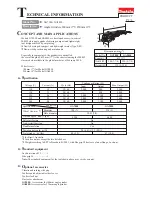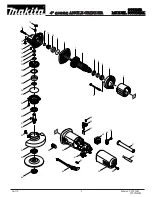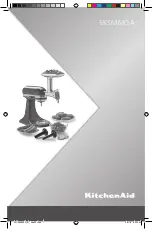
3
GETTING STARTED
SAFETY / SPECIFICATIONS
ASSEMBLY / INSTALLATION
OPERATION
TROUBLESHOOTING
MAINTENANCE / REPAIR
GETTING STARTED
Save this manual
You will need this manual for the safety warnings and
precautions, assembly instructions, operating and maintenance
procedures, parts list and diagram. Keep your invoice with this
manual. Write the invoice number on the inside of the front cover.
Keep this manual and invoice in a safe and dry place for future
reference.
Electrical requirements
The power supply to the Grinder / Sharpener Machine
needs to be 115V, 60Hz. The standard allowable
voltage variation is a plus or minus 10%.
UNPACKING
Open the shipping and product carton. After unpacking the
Grinder / Sharpener Machine inspect it carefully for any
damage that may have occurred during transit. Check for loose,
missing or damaged parts. If any damage or loss has occurred,
claim must be filed with the carrier immediately. Check for
completeness. Immediately report missing parts to dealer.
A list of items included with your machine is shown on page 4.
Inspect:
• All tools should be visually inspected before use, in
addition to regular periodic maintenance inspections.
• Be sure that the voltage labeled on the unit matches
your power supply.
• See General Safety Instructions, Cautions and
Warnings as shown.
SAFETY RULES
For your own safety, read all of the
instructions and precautions before
operating tool.
Always follow proper operating
procedures as defined in this manual even
if you are familiar with the use of this or similar tools.
Remember that being careless for even a fraction of a
second can result in severe personal injury.
PROPOSITION 65 WARNING:
Some dust created by
using power tools contain chemicals known to the state
of California to cause cancer, birth defects or other
reproductive harm.
Some Examples of these chemicals are:
• Lead from lead-based paints.
• Crystalline silica from bricks and cement and other masonry
products
• Arsenic and chromium from chemically-treated lumber.
Your risk from these exposures varies, depending on how often
you do this type of work. To reduce your exposure to these
chemicals: work in a well ventilated area and work with approved
safety equipment. Always wear
OSHA/NIOSH
approved, properly
fitting face mask or respirator when using such tools.
Preparing for your job
• Wear safety glasses complying with United States ANSI
Z87.1. Everyday glasses have only impact resistant lenses.
They are not safety glasses.
• Wearing an OSHA/NIOSH approved, properly fitting face
mask or respirator is highly recommended.
• Wear proper apparel when using power tools. Do not wear
loose clothing, gloves, neckties, rings, bracelets or other
jewelry which may get caught up in moving parts of machine.
• When using power tools, wear protective hair covering to
contain long hair.
• Wear safety shoes with non-slip soles.
• Be alert and think clearly. Never operate power tools when
tired, intoxicated or when taking medications that cause
drowsiness.
Preparing the work area for your job
• Keep work area clean. Cluttered work areas invite accidents.
• Do not use the Grinder / Sharpener Machine in dangerous
environments or where explosive fumes exist. Do not use
the machine in damp or wet locations. Do not expose power
tools to rain.
• Work area should be properly lighted.
• Proper electrical receptacle should be available for tool.
Three-prong plug should be plugged directly into properly
grounded three-prong receptacle.
• Extension cords should have a grounding prong and the
three wires of the extension cord should be of the proper
gauge.
• Keep visitors at a safe distance from work area.
• Keep children out of workplace. Make workshop childproof.
Use padlocks, master switches or remove switch keys to
prevent any unintentional use of power tools.
Maintaining your tool
• Always unplug tool and remove it from its power source prior
to inspection. Never unplug the tool by pulling on the cord.
• Consult this manual for specific maintaining and adjusting
procedures.
• Keep the tool clean for safest operation. Chip debris build
ups can become combustible.
• Check for damaged parts. A part that is damaged should
be properly repaired or replaced. Do not perform makeshift
repairs. (Use the parts list in this manual to order repair
parts). Repairs must be made by a qualified technician.
• Never operate the machine without all safety guards in place.
Bypassing, deactivating or removal of a safety device in any
way endangers you.


































